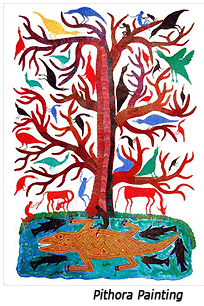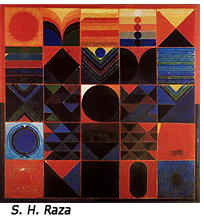- Prelude
- Guest Editor’s Column
- Hard Talk
- Digital Art
- The Write Stuff
- The Art of the Shakers : Shaker Furniture
- New Media
- In the News
- GenNext
- Report
- Artist Index and Statistics
- Market Insight
- Auction Reports
- The month that was
- Mumbai Artsighting
- Musings from Chennai
- Delhi Dias
- Deccan Odyssey
- Art Bengaluru
- In between – from Vadodara
- North-East Opsis
- A Tryst with Art in Madhya Pradesh
- Strands of Social Semiotics
- Transcending Popular
- Art of the Land & Land in Art (part I)
- Through The Patina
- Earth
- Go See India
- Dali's Elephant
- Malleable Memory
- Creative Impulse
- Different hues of Aakriti
- Bonhams : Fine Writing Instruments New York
ART news & views
A Tryst with Art in Madhya Pradesh
Volume: 2 Issue No: 7 Month: 8 Year: 2010
Tracing the history of art in Madhya Pradesh
Though art is not bound by space and time, yet time leaves its traces on it because man lives those times and in the course preserves experiences of his times--consciously or unconsciously--in paintings, songs, lores and legends. Thus, one needs to turn the pages of history to re-discover his identity, the identity of being a part of perpetual continuity of his existence. This very impulse incited in me an urge to peel off the layers of time to become a witness of this continuity. The same urge led me far beyond the dark recesses of pre-historic caves of Madhya Pradesh. The caves of Bhimbetka, Hinglajgarh, and Jogimara are the living examples of aesthetic experiences of our ancestors. When one enters these caves, he finds the rocks speaking the earliest traces of human life. These rock paintings depict the transition and growth of human.  The scenes of hunting, dancing, celebration leave you spell-bound. Made thousands of years ago, these rock paintings still bear the testimony of man's innate sense of art. Once completely absorbed in this pre-historic world of majestic tree gods, magical chariots, and jubilant dancing folk, one can find the delight of rediscovering his own traces in times coming unto him.
The scenes of hunting, dancing, celebration leave you spell-bound. Made thousands of years ago, these rock paintings still bear the testimony of man's innate sense of art. Once completely absorbed in this pre-historic world of majestic tree gods, magical chariots, and jubilant dancing folk, one can find the delight of rediscovering his own traces in times coming unto him.
Out from the caves, when man retraces his steps in his march through time, he finds himself in close communion with nature. Now in the open sky and bright sunshine, he is no more shy to carve his experiences and desires in the close, dark caves. In the course of time he developed a sense of belongingness; belongingness to everything in this cosmos and his consciousness to preserve this belongingness became what we call tradition. Tradition, as I understand is a sense of unity and continuity that bridges the gap of historical times. To catch a glimpse of this living tradition, one needs to peep into the tribal world. Madhya Pradesh maps a large part of this tribal world including Bhil, Gond, Agaria, Kol, Pardhan (to name a few). Due to this diverse tribal population, Madhya Pradesh has acquired a unique identity in art and culture, specially tribal paintings of Madhya Pradesh are distinguished for their artistic exhilaration, their charm and elegance, their wisdom and knowledge. They show a wide range of responses to vital elements of tribal life and their existence. Their religious devotion, myths, legends, rituals are activated into their art. These artistic expressions are clearly exemplified in Pithora and Mandana wall and floor paintings. Pithora is the style of expression popular among Bhils, Bhilals, Rathwa tribes of Madhya Pradesh. For them it is not merely an art form but a ritual performed to appear the God, Pithoro. They are delineated with themes of wedding, childbirth, festivals in elaborate details. Like Pithora, Mandava wall and floor paintings of Malwa, Nimar, Tanwargarh render religious sentiments of the artists. In Mandana paintings common and recurring motifs of cats, peacocks, lions, swastick etc. are drawn by using red clay and cow dung. Whether it is Pithora or Mandana wall paintings or terracotta horses, bulls, elephants of Bastar and Jhabua, they all are propagating tribal tradition and culture. Artists like Jangan Singh Shyam, Bhuri Bai, Ladoo Bai, Nankushia Bai Shyam (the list goes on ....) are the part of this vast tradition.  Now their art is no more confined on the walls of their village houses and temples but has begun to appear in the world art markets.
Now their art is no more confined on the walls of their village houses and temples but has begun to appear in the world art markets.
While tribal art is protecting its identity in articulating the collective sensibilities, with the passage of time new manifestations also started coming to the fore. Man in the urban world developed the tendency of breaking himself free from his identity in conformity with the pre-existing traditionalities and relates himself with a wider world, but in the process of transition he might be lost. This awareness of losing his individual existence leads him to embark on the journey of re-discovering his own self to articulate his individual sensibilities strongly. This awareness led to the emergence and evolution of contemporary trends in India. Madhya Pradesh is not untouched by these new tendencies.
The contemporary art movement in Madhya Pradesh started from Indore in the year 1927. With the efforts of D.D. Devlalikar who founded the Indore school of art and is considered as the pioneer of modern art movement in Madhya Pradesh, a new trend emerged and artists began to reflect new aspirations. From Indore the contemporary art movement then spread in Gwalior, Jabalpur and Dhar also. Besides Devlalikar, others who have given important contribution in further reviving the movement and generating an environment conducive to progressive trends in art are Vishnu Chinchalkar, Dr. J. Joshi, C.R. Vakankar, and Narayan Shridhar Bendre. With the sole efforts of M.S. Bhand, Gwalior also became one of the art training centers in Madhya Pradesh after Indore. During this time Ujjain was also becoming an important place for art activities, particularly with the establishment of Kalavrat Nyas and Kalidas Academy--where art camps and exhibitions are the regular feature--in which artists from all over India come to participate.
In the year 1947 Progressive group was formed with the artists like S.H. Raza, M.F. Husain--the artists dominating the world of art today--were also raised in and emerged from the soil of Madhya Pradesh. Raza and Husain are the names who have brought new dimensions of radical expressions in art. Other outstanding artists of this time are L.S. Rajput, Madan Bhatnagar, S.K. Das, and Hari Bhatnagar. Later  Suresh Chaudhari and Sachida Nagdev came in the lineage, whose contribution in the contemporary art is also remarkable.
Suresh Chaudhari and Sachida Nagdev came in the lineage, whose contribution in the contemporary art is also remarkable.
Recognizing the need to create a culture quintessential for creative art activities, Madhya Pradesh government established Kala Parishad in Bhopal, in the year 1952. Now with the inception of Kala Parishad and then Bharat Bhawan in the year 1982, Bhopal became an epicenter of art. With the unique contribution and dedication of the great artist Swaminathan, Bharat Bhawan became a live centre of creative activity. Swaminathan's contribution to Indian contemporary art is irrefutable. He moved away from the conventions and gave Indian contemporary art a new language. His works are the celebration of his inner ecstatic being. His colours and forms pulsate with vibrant energy.
During the times when Swaminathan was serving as the director of Roopankar, Bharat Bhawan young artists from different parts of Madhya Pradesh started coming here to find a platform for their art activities. Among this generation of artists, Yusuf is one of the significant names. His works have been greatly acknowledged for their rich visual rendering and for the magic he creates through the power of his rhythmic lines. Other important names of this generation of artists are Seema Ghuraiya, Akhilesh, Jaya, Vivek, and Robin David. They are receiving due acknowledgement--both from within the country and abroad-- for their individual style of expression. Today Madhya Pradesh is nourishing many new talents who are finding fresh grounds to showcase their creative sensibilities.
- Saba Gulraiz